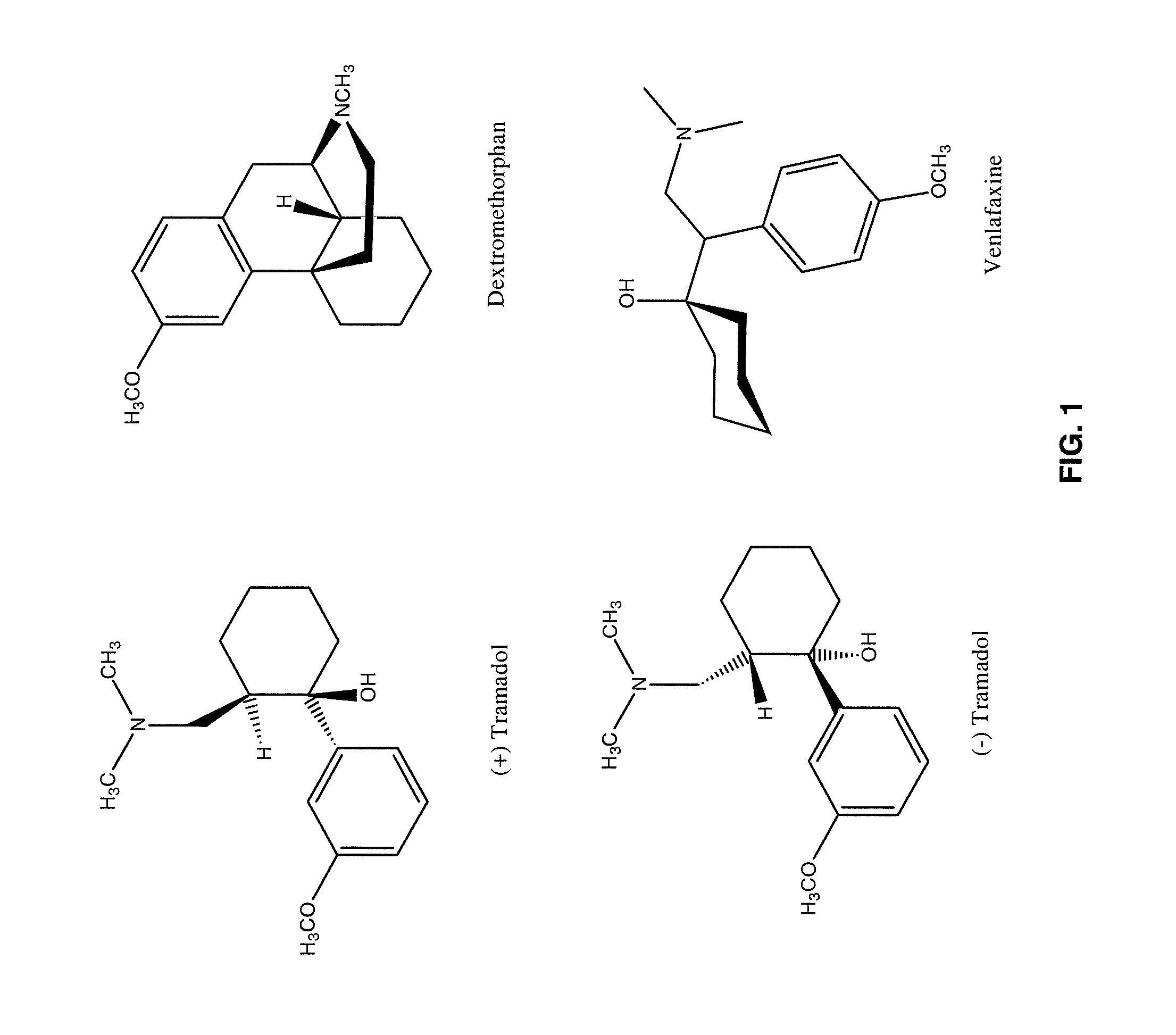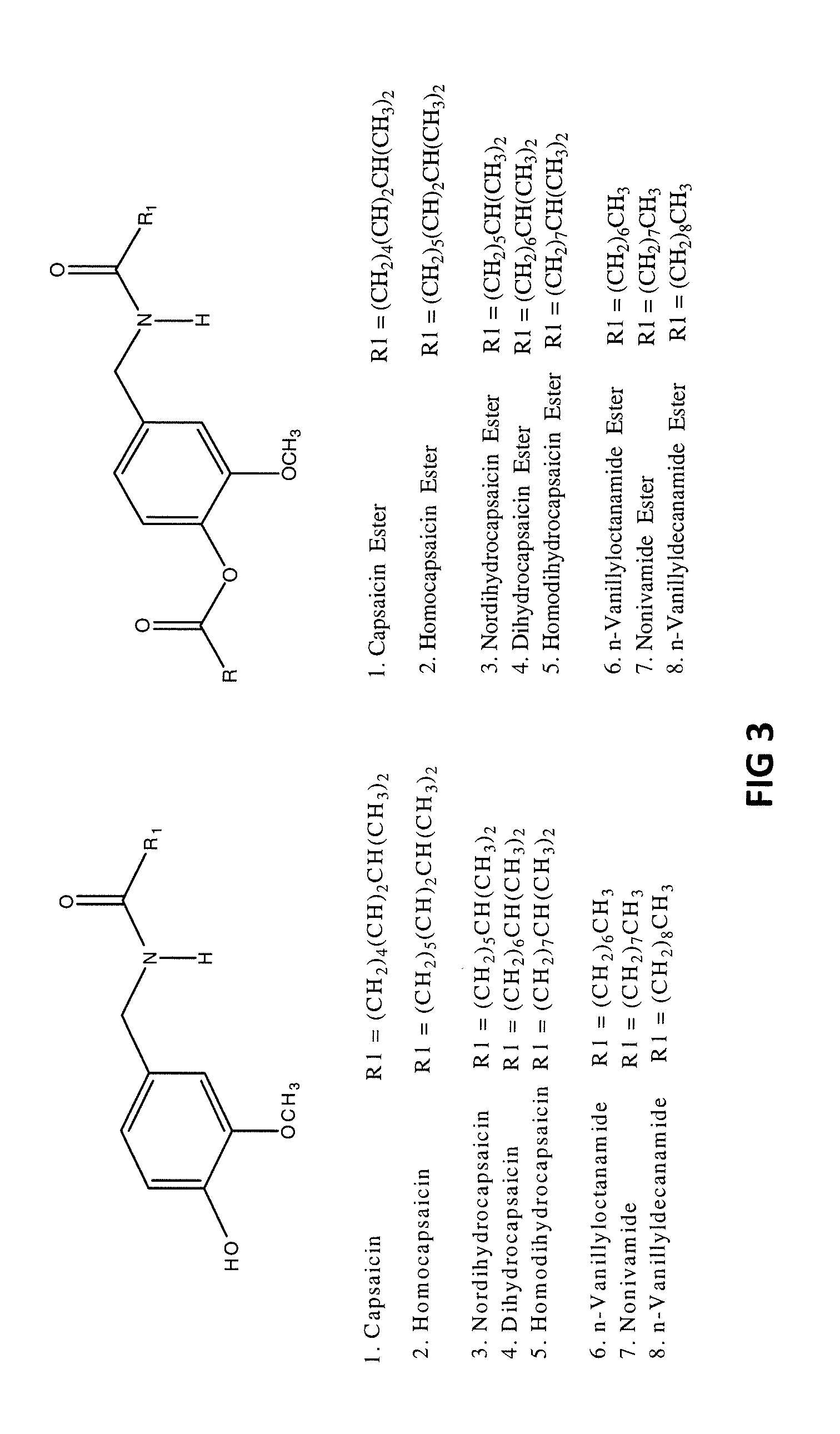Novel Pharmaceutical Compositions for Treating Chronic Pain and Pain Associated with Neuropathy
a neuropathy and composition technology, applied in the field of compositions for treating pain, can solve the problems of increasing the clinical utility of certain situations, not increasing the analgesic effect, and not understanding the pathophysiology of chronic pain
- Summary
- Abstract
- Description
- Claims
- Application Information
AI Technical Summary
Benefits of technology
Problems solved by technology
Method used
Image
Examples
example 1
Capsule Formulation Containing Gabapentin
[0397]The following ingredients in each one of the capsule formulations were weighed accurately, ground using a pestle and mortar to fine and homogeneous powders. These powders were sieved through 100 mesh and filled into hard gelatin capsules. The composition of each capsule formulation is listed below.
[0398]Capsule Formulation 1
In eachIn 100Tramadol Hydrochloride39.8 mg3.98 gDextromethorphan Hydrochloride51.0 mg5.10 gGabapentin90.0 mg9.00 gMicrocrystalline Cellulose27.6 mg2.76 gSodium Lauryl Sulfate 1.6 mg0.16 gTotal Solid 210 mg21.0 g
[0399]Capsule Formulation 2
In eachIn 100Tramadol Hydrochloride39.8 mg3.98 gDextromethorphan Hydrochloride51.0 mg5.10 gGabapentin180.0 mg 18.00 g Microcrystalline Cellulose77.4 mg7.74 gSodium Lauryl Sulfate 1.6 mg0.16 gTotal Solid 350 mg35.0 g
[0400]Capsule Formulation 3
In eachIn 100Tramadol Hydrochloride35.0 mg3.50 gDextromethorphan Hydrochloride45.0 mg4.50 gGabapentin90.0 mg9.00 gMicrocrystalline Cellulose36.5...
example 2
Capsule Formulation Containing Pregabalin
[0402]The following ingredients in each one of the capsule formulations were weighed accurately, ground using a pestle and mortar to fine and homogeneous powders. These powders were sieved through 100 mesh and filled into hard gelatin capsules. The composition of each capsule formulation is listed below.
[0403]Capsule Formulation 1
In eachIn 100Tramadol Hydrochloride39.8 mg3.98 gDextromethorphan Hydrochloride51.0 mg5.10 gPregabalin15.0 mg1.50 gMicrocrystalline Cellulose102.6 mg 10.26 g Sodium Lauryl Sulfate 1.6 mg0.16 gTotal Solid 210 mg21.0 g
[0404]Capsule Formulation 2
In eachIn 100Tramadol Hydrochloride39.8 mg3.98 gDextromethorphan Hydrochloride51.0 mg5.10 gPregabalin30.0 mg3.00 gMicrocrystalline Cellulose87.6 mg8.76 gSodium Lauryl Sulfate 1.6 mg0.16 gTotal Solid 210 mg21.0 g
[0405]Capsule Formulation 3
In eachIn 100Tramadol Hydrochloride35.0 mg3.50 gDextromethorphan Hydrochloride45.0 mg4.50 gPregabalin20.0 mg2.00 gMicrocrystalline Cellulose106....
example 3
Capsule Formulation Containing Amitriptyline
[0407]The following ingredients in each one of the capsule formulations were weighed accurately, ground using a pestle and mortar to fine and homogeneous powders. These powders were sieved through 100 mesh and filled into hard gelatin capsules. The composition of each capsule formulation is listed below.
[0408]Capsule Formulation 1
In eachIn 100Tramadol Hydrochloride39.8 mg3.98 gDextromethorphan Hydrochloride51.0 mg5.10 gAmitriptyline Hydrochloride11.4 mg11.40 g Microcrystalline Cellulose106.2 mg 106.2 g Sodium Lauryl Sulfate 1.6 mg0.16 gTotal Solid 210 mg21.0 g
[0409]Capsule Formulation 2
In eachIn 100Tramadol Hydrochloride39.8 mg3.98 gDextromethorphan Hydrochloride51.0 mg5.10 gAmitriptyline Hydrochloride 5.7 mg5.70 gMicrocrystalline Cellulose111.9 mg 11.19 g Sodium Lauryl Sulfate 1.6 mg0.16 gTotal Solid 210 mg21.0 g
[0410]Capsule Formulation 3
In eachIn 100Tramadol Hydrochloride35.0 mg3.50 gDextromethorphan Hydrochloride45.0 mg4.50 gAmitriptyl...
PUM
| Property | Measurement | Unit |
|---|---|---|
| ionic strength | aaaaa | aaaaa |
| solubility | aaaaa | aaaaa |
| apparent volume of distribution | aaaaa | aaaaa |
Abstract
Description
Claims
Application Information
 Login to View More
Login to View More - R&D
- Intellectual Property
- Life Sciences
- Materials
- Tech Scout
- Unparalleled Data Quality
- Higher Quality Content
- 60% Fewer Hallucinations
Browse by: Latest US Patents, China's latest patents, Technical Efficacy Thesaurus, Application Domain, Technology Topic, Popular Technical Reports.
© 2025 PatSnap. All rights reserved.Legal|Privacy policy|Modern Slavery Act Transparency Statement|Sitemap|About US| Contact US: help@patsnap.com



